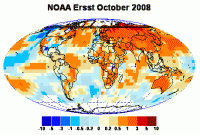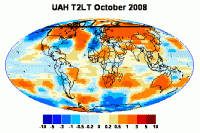
|
Nov 25, 2008
GHCN Updates
By Steve McIntyre, Climate Audit
In its land surface temperature calculations, NASA GISS is little more than a distributor for NOAA GHCN. As Gavin Schmidt explained, they spend no more than 0.25 man-years on this product, which permits negligible (if any) quality control. Although there are 7280 stations in the GHCN network, only a fraction of these occur as up-to-date records in GHCN (or their distributor), even from countries where up-to-date information is easy to locate (e.g. Canada, New Zealand). I’ve discussed this bizarre failure to update station data on many occasions in the past.
Aside from seemingly poor practice, a further issue for me and others is whether some kind of bias has been introduced into the system by the discontinuity. Assessing this potential bias is not a small job and one that NOAA and NASA should obviously have done long ago and existing literature does not do so. An obstacle to assessing such a bias has been the lack of any clear description of the update program. In my recent review of the data, I noticed a couple of scraps of information and have now constructed what I believe to be a reasonable accurate inventory of the stations that are included in the GHCN update program.
Peterson et al (BAMS 1997) reported the following update procedure: Of the 31 sources, we are able to perform regular monthly updates with only three of them. These are 1) the U.S. HCN, 1221 high quality, long-term, mostly rural stations in the United States; 2) a 371-station subset of the U.S. First Order station network (mostly airport stations in the United States and U.S. territories such as the Marshall and Caroline Islands in the western Pacific); and 3) 1502 Monthly Climatic Data for the World stations (subset of those stations around the world that report CLIMAT monthly code over the Global Telecommunications System and/or mail reports to NCDC). Other stations will be updated or added to GHCN when additional data become available, but this will be on a highly irregular basis.
When they said that the “other stations” would be updated on a “highly irregular basis”, they were not joking. In the 11 subsequent years, as far as I can tell, there have been no such updates. We’ve already collated information on the 1221 USHCN sites, but the GHCN website unfortunately doesn’t provide any lists of either the 1502 MCDW stations or 371 First Order stations.
NASA GISS makes an effort to adjust for UHI. As noted elsewhere, their procedure in the US is considerably different than their procedure outside the US, as, in the US, the USHCN network, whatever its warts, provides many stations that are not in urban airports. There is scattered information on non-US stations, but this is clearly a major lacuna at present (and I’m sending a copy of this list to Anthony in the hope that this topic will interest him - which seems likely given the interesting recent posts at his site on Verhoyansk in Russia). The Russian (and western China) sites seem like excellent first targets as they have a lot of leverage in overall land-based aggregates. Read more of the post and comments here.
Read also Climate Audit post on the NOAA GHCN comparison with NASA UAH global temperatures here.


While the major patterns are similar in both data sets, there are some intriguing differences. NOAA surface coverage of the Southern Hemisphere looks decidedly scrappy beside UAH. While both NOAA and UAH show a cool “ridge” in the ocean offshore western Europe, it’s much larger in the UAH version. The tropical Pacific and northern Pacific are cooler in UAH. But it’s not all the same direction - UAH western Canada is warmer than NOAA western Canada.
Nov 25, 2008
Indonesia’s Climate Follows the Sun
By Dr. Willie Soon and Lord Christopher Monckton
Carbon dioxide is not an air pollutant. It is plant food. All life on Earth depends on it. It is natural. It forms the bubbles in bread, champagne, and Coca-Cola. You breathe it out, and plants breathe it in. The Earth contains a lot of CO2, but the atmosphere contains so little that the United Nations’ Intergovernmental Panel on Climate Change (IPCC) rightly calls CO2 a “trace gas”. A scientific mystery is why the air does not hold more CO2 than it does. Half a billion years ago, there was almost 20 times today’s CO2 concentration.
Most farmers would prefer to grow crops under much-higher concentrations of CO2 than today’s 385 parts per million - less than 1/25 of 1 percent of the atmosphere. To feed the world, low CO2 concentration is not such a great idea. High concentrations are better, and they cause no harm. Experiments have shown that even delicate plants such as orchids thrive at CO2 concentrations of 10,000 ppm. That is why U.S. Supreme Court Justice Anthony Scalia has declared that if CO2 is to be labeled an “air pollutant”, then so must Frisbees and flatulence.
What about the danger of overheating the Earth by CO2? Al Gore is spending $300 million telling us “global warming” will be a catastrophe. Yet a survey of 539 scientific papers containing the words “global climate change” and published between January 2004 and February 2007 found not a single one that provided any evidence that “global warming” would be catastrophic. It does not matter how many scientists or politicians say that more CO2 will cause a catastrophe. To true scientists, what matters is whether any real-world data support the idea.
If CO2 is a powerful greenhouse gas, we would have seen a great warming trend in Indonesian temperature history. We haven’t. Recent temperatures, according to the Tyndall Centre for Climate Change Research, have been scarcely warmer than they were 70 to 100 years ago. Instead of a strong warming trend, the Indonesian data are dominated by year-to-year changes and natural oscillations every 50 to 100 years.

Look to matahari (the sun in Bahasa Indonesia) rather than CO2 as the key player in Indonesia’s climate. Read more here.
Nov 22, 2008
Myths About Energy Threaten Future of Nation
By Barry Cleveland, Carmi Times
Fossil fuels are not ruining the environment, the world is not running out of oil and the U.S. can never be energy independent.Brad Richards, executive vice president of the Mt. Vernon-based Illinois Oil & Gas Association, took issue Thursday in Carmi with “three myths that threaten our country.”
He also took issue with the idea that the world is running out of oil. U.S. crude oil production peaked in the early 1970s and it may well be that world production has peaked recently, he said. But there will be no precipitous decline in production across the globe, he said. Instead, “Supply and demand will reach an uneasy equilibrium. And we’ll have a bumpy plateau of production for decades to come; extreme volatility will be the rule."The world is not running out of oil, he said, but it is running out of cheap, easily-found oil. Still, “there’s no way to run away from oil” entirely, he cautioned.Richards told the group that U.S. energy independence is “neither do-able nor desirable.” The truth is that the world is becoming more interdependent, he said, and unrealistic talk of energy independence hampers realistic discussion of the matter.
“It’s feel-good talk,” he said, but even aggressive development of alternative energy sources wouldn’t begin to provide the volume of energy now derived from fossil fuels."The truth is,” said Richards, “that we’re all married to fossil fuels.” And he predicted that this won’t change for 30 to 50 years, adding that the U.S. should “accept the reality of energy interdependence.” The club was told that crude oil now provides about 39 percent of the energy that the U.S. uses, natural gas 24 percent, coal 23 percent, nuclear power eight percent and hydroelectric power three percent. And Richards noted that environmentalists don’t like any of these sources.
Sadly, however, just as the nation can’t drill its way to energy independence, it can’t build enough windmills or install enough solar panels to replace fossil fuels.There are encouraging signs. U.S. natural gas production is expected to increase by eight percent this winter to a 35-year high, thanks to higher prices and new technology. What’s going on in the U.S. industry is “amazing” and “unbelievable,” Richards told the club, with horizontal drilling and other technologies being used to find and exploit huge gas fields. While admitting that John McCain was not the ideal candidate of the U.S. energy industry, Richards made it clear that the industry has little enthusiasm for the president-elect.
Barack Obama called for a new windfall profits tax on oil when the price of crude was over $100, Richards said. A similar tax didn’t work in the ‘70s; it increased the nation’s dependence on foreign oil, depressed domestic exploration and generated less than 25 percent of what was projected. More of the same could be expected if a new tax were implemented now, he added."Let free markets, not the government, make energy choices,” Richards told the crowd. Asked about the viability of tar sands and oil shales as energy sources, the speaker said they’re realistic if crude oil stabilizes at $90 a barrel or so. Read more here.
Nov 22, 2008
Global Warming? Bring it On!
By Gregory Young
The argument propounded by the dubious United Nations’ Intergovernmental Panel on Climate Change (IPCC) report on Anthropogenic (human-induced) Global Warming (AGW) is willfully fraudulent. The report has been vigorously and critically undermined, scientifically denounced and found wanting from both notable scientists here and abroad.
In spite of this fact, it is likely that the new U.S. Democratic Congress and Administration will once again proclaim that they know better than we do about such things. Get ready for them to move surreptitiously under the guise of Global Climate Control in an effort to enhance their own legacies and pocketbooks. To be sure, the Left hears nothing but their own incestuous voices, despite the voices of clarity and reason that abound around them. And there are many, many distinguished dissenters against the charade of AGW.
Let me assure you that we’re not in good humor, nor take it kindly to be slurred and ridiculed by taking the other side in this debate. And our numbers are still growing. Indeed, we’re angry that the vast majority of American Scientists will not be heard by the media. We’re dismayed over the fact that the Global Warming fiasco has become politically popular and expedient to those left-wing politicians and power-brokers whose sole aim is to literally tax everything with a carbon footprint and give them control over all life, hidden within their PC guileful pretence to save the planet. They wish to save no one but themselves.
And the tide turns further. Of the 2500 originally aligned scientists and putative authors of the UN’s IPCC report some 500 are no longer faithful to Big Al’s errand. Many of these scientists discovered that their individual findings and comments were willfully misrepresented. All participant conclusions were unilaterally changed to adhere strictly to the United Nations objective of building support for world taxation and rationing of industrially useful energy. Since the original IPCC report (and there have been some 4 others now formally issued), the defecting 500 scientists have issued public statements challenging global warming. Approximately 100 of these scientists are now open defectors. Others are currently suing the UN for the misuse of their good names and research. It is difficult to see why a thinking person would even consider the IPCC report as legitimate.
The entire IPCC process is but obfuscation by the secular and atheist Left. It has allowed the Left to conflate the vanity of secular opinion with scientific and/or moral truth. There is an easy and immediate remedy for their debacle. Will Rogers stated it simply: “When you are in a hole ... stop digging.... Please!” Read full post here.
Dr. Gregory Young is a neuroscientist and physicist, a doctoral graduate of the University of Oxford, Oxford, England. He is currently involved with a privately funded think-tank engaged in experimental biophysical research.
Nov 19, 2008
NOAA GHCN has Global Temperatures for October 2nd Warmest (Don’t Believe It)
USA TODAY
The Earth’s temperature for the month of October was the second-warmest since records began in 1880, according to data from the National Oceanic and Atmospheric Administration. The month’s average temperature of 58.2 degrees was 1.1 degrees above the 20th century average of 57.1 degrees, trailing only October 2003. For the Earth’s land areas, it was the warmest October on record.
And this NOAA data does include the correct October temperature data for Russia...unlike NASA’s October data released last week, which caused the agency to end up with egg on its face. After NASA announced that October was the warmest ever recorded, eagle-eyed bloggers at skeptic blogs Climate Audit and Watts up with that pointed out that the data from Russia was for September, not October. Of course, this skewed the global temperature higher than it would have been.
Even if you don’t agree with all (or any) of the points or claims posited by the warming skeptics, I think they are doing a needed service by keeping the climate change adherents, such as authors of the RealClimate blog, on their toes. RealClimate’s Gavin Schmidt addressed this in this post: “the extra attention has led to improvements in many products. Nothing of any consequence has changed in terms of our understanding of climate change, but a few more i’s have been dotted and t’s crossed.”
Indeed, as noted above, even with the correct October data from Russia, temperatures across Australia, Asia (including Russia), the western USA, eastern Europe, northern Canada, eastern Brazil, and the southern countries of South America were all warmer-than-average in October. And so far this year, 2008 is the ninth-warmest year on record for the planet, with all nine of the Earth’s warmest years occurring since the mid-1990s. See post here.
This is not surprising as NOAA has become the biggest outlier in recent months. They have thanks to Tom Peterson and Tom Karl a global data base that is worth nothing. There is little or no adjustment for urbanization, land use changes, no adjustment for bad station siting (69% of the 560 US climate stations surveyed by Anthony Watts team of volunteers were poor or very poorly sited), 2/3rds of the stations globally dropped out around 1990, the number of missing months increased tenfold in the FSU and Africa after 1990, and changes in instrumentation like here in the US that Tom Karl himself found produced a warm bias of 0.5F. All these introduce a warm bias, none of which are corrected for. Not less than 6 peer review studies (bold in references) have shown these issues may account for up to 50% of the warming since 1900. Trust only the satellite. In fact, this October was the 10th warmest of the 30 years of data for the MSU satellite according to UAH with only a 0.167C (0.3F) anomaly instead of the 1.1F (2nd warmest out of 129 years) as per NOAA. Unfortunately satellite data extends only back to 1979.
|
|
|
|





